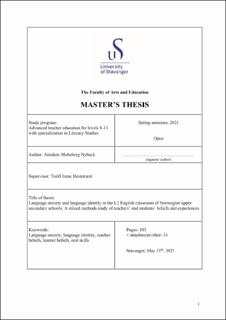| dc.description.abstract | This research project is a mixed methods study exploring language anxiety and language identity in the L2 English classroom of Norwegian VG1 classes. The study aimed to investigate and compare the teachers’ and students’ beliefs about these aspects and explore how their beliefs reflected current research literature. The study placed particular emphasis on language anxiety in relation to the development of oral skills. It also sought to examine the possible relationships between language anxiety and language identity. In particular, the study aimed to answer four main research questions. Two research questions sought to explore the teachers’ and students’ beliefs and experiences regarding language anxiety in the English subject classroom. The third research question aimed to investigate the teachers’ and students’ beliefs about how language anxiety may influence language development. The final research question aimed to examine the teachers’ and students’ beliefs about language identity and its possible relationship to language anxiety.
In exploring this topic, the study employed a mixed methods research design, combining interviews and a questionnaire. Three English teachers in three different Norwegian upper secondary schools were interviewed to gain a perspective of the teachers’ beliefs and experiences. Similarly, six of the students the teachers taught were interviewed to gain a perspective of the students’ beliefs and experiences. Lastly, a student questionnaire was completed by 136 students in the respective schools.
First, the present study found that the teachers’ and students’ beliefs about language anxiety were fairly similar. Their beliefs also reflected previous research on language anxiety. The participants believed that various personality traits, previous experiences, fear of evaluation, and the increasing pressure to perform well contributed to language anxiety. However, the students added the fear of peer ridicule as a source of language anxiety. To alleviate language anxiety, the teachers and students believed engaging tasks, oral activities in groups, and a safe classroom environment to be essential factors.
Second, the participants reported various experiences with language anxiety. Neither of the teachers had learned about language anxiety during their education. However, numerous students reported having experienced language anxiety. The students explained that the most anxiety-provoking activities were oral presentations, group discussions, reading aloud, and answering the teachers’ spontaneous questions. These experiences correlated with the teachers’ beliefs, who believed that speaking was the most anxiety-provoking activity. Nevertheless, some students reported having experienced peer ridicule after speaking English in class. The teachers reported never to have experienced this in their classes.
Third, the teachers and the students believed that language anxiety affected language development negatively. The teachers believed that it was essential for students to speak the language in order to learn it. The students generally believed that language anxiety would hinder them from demonstrating their oral skills.
Finally, the teachers’ and students’ beliefs were similar regarding language identity and the students’ strong desire to learn English. They believed that students who were increasingly exposed to English experienced less language anxiety, whereas a few students believed that the increasing exposure to English enhanced the pressure to perform well. Altogether, they believed that the increasing exposure to English influenced their language development positively since it allowed for meaningful and natural communication. Their beliefs correlated with research on language identity, suggesting a correlation between language skills and a strong motivation, desire, and investment to learn the language.
The overall goal from these materials was to shed light on contributing factors and possible effects language anxiety may have on Norwegian students’ development of oral skills. Besides, it gained a perspective on language identity and its possible relationship with language anxiety. Finally, it aimed to add valuable inquiry into the field of teacher and learner beliefs, to what extent their beliefs coincided, and to what extent their beliefs reflected research on teacher and learner beliefs. | |
